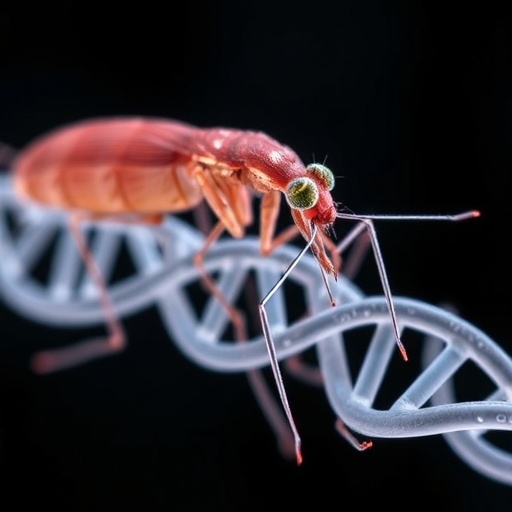In the evolving landscape of parasitic disease control, the latest developments in genetic manipulation of Leishmania parasites hold transformative potential. Recent advancements employing the revolutionary CRISPR/Cas9 genome editing system have opened new frontiers in understanding and combating leishmaniasis, a debilitating disease affecting millions worldwide. This breakthrough, meticulously detailed by Gundogdu and Islek, marks a pivotal moment in parasitology, fusing molecular biology with innovative vaccine strategies aimed at halting the spread of this resilient pathogen.
Leishmania parasites are notorious for their complex life cycle and ability to evade host immune responses, making traditional therapeutic approaches less effective. Genetic manipulation technologies have long been sought to dissect the parasite’s biology and identify vulnerabilities. However, limitations in earlier gene-editing tools constrained researchers’ ability to perform precise genomic alterations. The introduction of CRISPR/Cas9 has revolutionized this domain by allowing scientists to target and modify specific genes with unprecedented accuracy and efficiency.
Deploying CRISPR/Cas9 in Leishmania research provides dual advantages: it not only accelerates the functional characterization of genes involved in virulence and drug resistance but also facilitates the design of genetically attenuated strains for vaccine development. By knocking out key virulence factors or modifying metabolic pathways, researchers can engineer parasites incapable of causing disease, offering a safer and more effective vaccine platform than conventional approaches.
The intricate workflow of CRISPR/Cas9 editing in Leishmania begins with the design of guide RNAs that direct the Cas9 nuclease to precise genomic loci. Following DNA cleavage, the parasite’s repair machinery either inserts mutations disrupting gene function or incorporates exogenous sequences through homology-directed repair. This precision enables targeted gene disruption or gene tagging, enhancing our understanding of parasite physiology and its interaction with host cells.
One of the most compelling applications of this technology is the development of live attenuated vaccines. By strategically deleting genes critical for parasite survival or immune evasion, scientists can create strains that trigger robust immune responses without causing disease. Such vaccines promise long-lasting immunity, surpassing the protection offered by subunit or killed vaccines. This approach also paves the way for personalized vaccine formulations adjusted to regional parasite strains.
Furthermore, CRISPR/Cas9 facilitates high-throughput screening of potential drug targets by enabling systematic gene knockouts. This capability accelerates the identification of essential genes whose inhibition could render the parasite nonviable. Combined with advances in RNA interference and conditional gene expression systems, researchers now possess a versatile toolbox to interrogate Leishmania biology comprehensively, guiding the design of next-generation antiparasitic drugs.
While the promise of CRISPR/Cas9 is immense, several challenges remain. Efficient delivery of gene-editing components into Leishmania cells can be technically demanding, requiring optimization of transfection methods for different parasite species. Moreover, off-target effects and incomplete editing pose concerns that need addressing through improved guide RNA design and thorough validation protocols. Nonetheless, the rapid progress in these areas signals a bright future.
The genetic insights gleaned through CRISPR/Cas9 editing have also enriched our understanding of host-parasite dynamics. By elucidating how Leishmania manipulates host immune responses at the molecular level, new therapeutic strategies can be devised to bolster host defenses. For instance, modifying parasite surface proteins that interact with macrophage receptors reveals novel immunomodulatory pathways and potential vaccine antigens.
Beyond vaccine development, CRISPR-based approaches facilitate the exploration of Leishmania’s metabolic adaptability, which underpins its survival in diverse environments within mammalian hosts and sandfly vectors. Targeting metabolic enzymes essential for nutrient acquisition or stress response can disrupt the parasite’s lifecycle, offering novel points of intervention that circumvent resistance mechanisms affecting current drug regimens.
The implications of these advancements extend far beyond basic research. Field-applicable genetic tools allow for real-time monitoring of Leishmania genetic diversity and epidemiology, informing public health strategies. Genetically engineered parasites can act as biosensors or vectors for delivering immune modulators in endemic regions, creating integrated platforms for disease management that combine treatment and prevention.
Collaboration between molecular parasitologists, immunologists, and vaccine developers is critical to translating these laboratory successes into tangible clinical outcomes. As the technology matures, ethical and biosafety considerations surrounding the release of genetically modified organisms must be carefully navigated. Regulatory frameworks will need to evolve in tandem with scientific breakthroughs to ensure responsible deployment of novel interventions.
In summary, the fusion of CRISPR/Cas9 gene-editing with innovative vaccination strategies represents a paradigm shift in tackling leishmaniasis. This synergistic approach not only unravels the genetic secrets of Leishmania but also lays the groundwork for next-generation vaccines and therapeutics that could dramatically reduce the global burden of this neglected tropical disease. With continued investment and interdisciplinary collaboration, the vision of effective, genetically informed disease control is rapidly becoming a reality.
The strides made in genetic manipulation tools herald an era where parasitic diseases can be managed with the precision and sophistication previously reserved for cancer and genetic disorders. As Leishmania research accelerates, the lessons learned are poised to inspire similar transformations across other parasitic infections, contributing to a broader renaissance in infectious disease control fueled by gene editing technologies.
Ultimately, the work of Gundogdu and Islek provides a comprehensive roadmap for harnessing cutting-edge genetic tools to outsmart one of humanity’s oldest yet most elusive enemies. Their insights not only deepen our scientific understanding but also kindle hope for novel interventions that can break the cycle of infection, morbidity, and mortality associated with leishmaniasis worldwide. This research exemplifies the power of innovation to save lives by bridging molecular biology and public health in unprecedented ways.
Subject of Research: Genetic manipulation tools in Leishmania parasites, focusing on CRISPR/Cas9 and vaccine development strategies.
Article Title: Genetic Manipulation Tools in Leishmania: From CRISPR/Cas9 to Vaccine Strategies for Disease Control.
Article References:
Gundogdu, M., Islek, Z. Genetic Manipulation Tools in Leishmania: From CRISPR/Cas9 to Vaccine Strategies for Disease Control. Acta Parasit. 70, 217 (2025). https://doi.org/10.1007/s11686-025-01161-5
Image Credits: AI Generated




